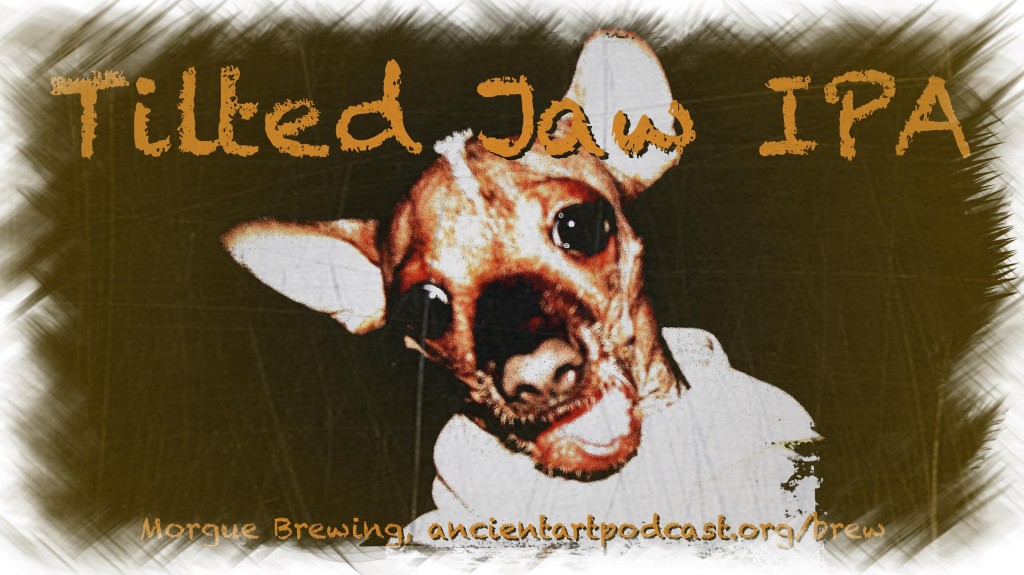I’m immeasurably more pleased with my second attempt at an IPA versus my first attempt. This batch is truly worthy of the name Tilted Jaw IPA. We’ve happily shared it with a few friends, who all seemed to enjoy it, including one particularly discerning IPA connoisseur.
We brewed on September 15, 2012, 10:00 p.m. I’m writing this post 2 months after brewing, so let’s hope my notes are accurate:
- 3 lbs Plain Extra Light Dried Malt Extract
- 3 lbs Plain Light Dried Malt Extract
- 1 lb Crystal Malt 20L (I used Thomas Fawcett & Sons)
- 1/2 lb Carafoam Malt
- 2 oz Chinook Pellet Hops [11.1% Alpha Acid] (At 60 minutes left in the boil)
- 1/2 oz Cascade Pellet Hops [6.2% Alpha Acid] (30 min)
- 1/2 oz Chinook Pellet Hops [11.1% Alpha Acid] (30 min)
- 1/2 oz Cascade Pellet Hops [6.2% Alpha Acid] (15 min)
- 1/2 oz Chinook Pellet Hops [11.1% Alpha Acid] (15 min)
- 1 oz Cascade Pellet Hops [6.2% Alpha Acid] (5 min)
- 1 packet (11 g, 0.388 oz) Lallemand Nottingham Dry Yeast
- For Dry Hop: 2 oz Cascade Pellet Hops [6.2% Alpha Acid]
I prefer to do a partial boil of about 2.5-3 gallons of water. A fair amount must have boiled off, because I added 3 gallons of chilled filtered tap water to the brew to get 5 gallons in the plastic carboy. I cooled the contents of the brew pot in an ice bath in the sink, but in hindsight maybe I won’t need to if I always chill the water addition. The temperature in of the 5 gallons was around 64-66 degrees Fahrenheit. Original Gravity at that temperature was about 1.070. (Okay, it was 1.073, so I threw in some more filtered tap water to get it down to 1.070, because that’s where I wanted it to be. Deal with it.)
Because I didn’t own a proper strainer at the time (have since purchased one), I put the whole contents of the pot in the carboy. Since I always use mesh bags for the grains and hops, the sludge in the pot is minimal and easily settles during fermentation. As mentioned in my previous post, Tilted Jaw IPA, 1st attempt (batch 4), when using dry yeast, I always prefer to hydrate and activate the little buggers. Per the instructions in Charlie Papazian’s The Complete Joy of Homebrewing, 3rd edition:
…[Boil] 1 1/2 cups (355 ml) of water for 5-10 minutes, pour into a sanitized glass jar (washed and boiled for about 15 minutes), cover with clean foil and let cool to 100-105 degrees F (38-41 C). Do not add any sugars. Add dried yeast and let rehydrate for 15-30 minutes, and then bring the temperature of the rehydrated yeast close to that of the wort and pitch. (Page 81)
After a good 12 hours, there was massive fermentation action in the carboy. I added a blowout tube instead of an airlock, but for some stupid reason it still blew its top and made quite a mess. The blowout tube didn’t seem to be blocked. Whatever.
On September 24, 8:30 p.m. (9 days into fermentation), I Dry Hopped the beer by adding the aforementioned 2 oz Cascade Pellet Hops in a reusable mesh bag to the plastic carboy with the beer.*
*For more on Dry Hopping, see John Palmer’s How to Brew, chapter 5.1, “Hops – How Are They Used?”
Bottling Day: October 2, 7:30 p.m.
Final Gravity was 1.011. Do the math and we get an Alcohol By Volume of:
(1.070 OG – 1.011 FG) x 131.25 = 7.74% ABV
The aroma and appearance were magnificent. We added the 5 oz package of priming sugar (diluted in about 2 cups boiling water) obtained from our local Brew & Grow and bottled the beer. Going forward, I may not bother with priming sugar, and simply use 1.25 cups (10 oz, about 300 ml) of Dried Malt Extract, per the instructions in Charlie Papazian’s most excellent The Complete Joy of Homebrewing, 3rd edition (page 29).
Waiting is always a challenge. We cracked open the first bottle on October 13. As I wrote in my post on Untappd:
Here’s the link to Tilted Jaw IPA on Untappd: http://untappd.com/beer/210947
Next time I might try all Chinook all the way. Perhaps even dry hop with some cedar wood chips. I’ve been itchin’ to do that for a while.




